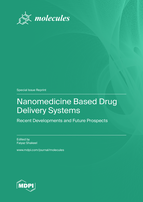Nanomedicine Based Drug Delivery Systems: Recent Developments and Future Prospects
A special issue of Molecules (ISSN 1420-3049). This special issue belongs to the section "Medicinal Chemistry".
Deadline for manuscript submissions: closed (31 December 2022) | Viewed by 40167
Special Issue Editor
Interests: bioavailability; nanomedicine; nanoemulsion; SNEDDS; solubilization; transdermal drug delivery system
Special Issues, Collections and Topics in MDPI journals
Special Issue Information
Dear Colleagues,
Since the discovery of nanomedicine-based drug delivery carriers such as nanoparticles, liposomes, and self-nanoemulsifying drug delivery systems (SNEDDS), enormous progress has been achieved in the field of innovative active biomolecule drug delivery systems. The use of nanomedicines as drug delivery carriers has garnered a lot of interest in recent years for the therapeutic targeting of specific cells. Biocompatibility, biodegradability, low toxicity, drug delivery efficiency, drug targeting efficiency, and improved solubility, bioavailability, and bioactivities are all advantages of these nanosized drug delivery carriers. Furthermore, these carriers can encapsulate a diverse range of active therapeutic biomolecules. These nanomedicine-based drug delivery carriers can also improve the pharmacokinetic and pharmacodynamics efficiencies of active therapeutic biomolecules, allowing for a more sustained, targeted, and controlled drug delivery system. Various studies have recently shown progress in nanomedicine-based drug delivery systems for future therapeutic targeting. This Special Issue aims to collect recent advances, developments, and future prospects on the design, development, characterization, and biological evaluation of nanomedicine-based drug delivery systems for active therapeutic biomolecules.
Dr. Faiyaz Shakeel
Guest Editor
Manuscript Submission Information
Manuscripts should be submitted online at www.mdpi.com by registering and logging in to this website. Once you are registered, click here to go to the submission form. Manuscripts can be submitted until the deadline. All submissions that pass pre-check are peer-reviewed. Accepted papers will be published continuously in the journal (as soon as accepted) and will be listed together on the special issue website. Research articles, review articles as well as short communications are invited. For planned papers, a title and short abstract (about 100 words) can be sent to the Editorial Office for announcement on this website.
Submitted manuscripts should not have been published previously, nor be under consideration for publication elsewhere (except conference proceedings papers). All manuscripts are thoroughly refereed through a single-blind peer-review process. A guide for authors and other relevant information for submission of manuscripts is available on the Instructions for Authors page. Molecules is an international peer-reviewed open access semimonthly journal published by MDPI.
Please visit the Instructions for Authors page before submitting a manuscript. The Article Processing Charge (APC) for publication in this open access journal is 2700 CHF (Swiss Francs). Submitted papers should be well formatted and use good English. Authors may use MDPI's English editing service prior to publication or during author revisions.
Keywords
- Carbon nanotubes
- Liposomes
- Metallic nanoparticles
- Nanocarriers
- Nanoemulsions
- Nanostructured lipid carriers
- Niosomes
- Polymeric nanoparticles
- Solid lipid nanoparticles
- Self-nanoemulsifying drug delivery systems







